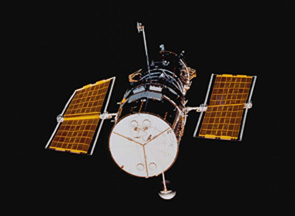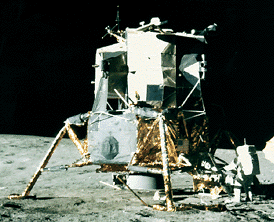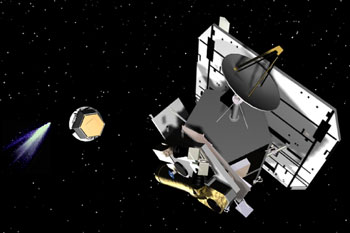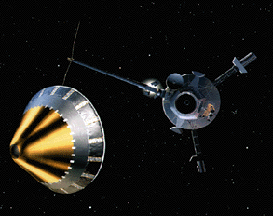Picture of Suisei spacecraft
the Institute of Space and Aeronautical Science
Sakigake & Suisei
Sakigake and Suisei are nearly identical Japanese spacecrafts, designed to fly by Halley's comet and study its effects on space environment.
Sakigake was launched on Jan. 7, 1985, followed by Suisei on August 18, 1985. The two headed for Comet Halley, passing by it and returning ultraviolet images and measurements of its interaction with the solar wind. Sakigake flew within 7 million km (4.4 million miles) while Suisei came within 98,000 miles, even suffering 2 dust impacts from the comet's tail. The spacecrafts were both given new directions and both were scheduled to encounter Comet Giacobini-Zinner in 1998. Suisei ran out of fuel in 1991, and contact with it has been lost. Sakigake ran out of fuel in 1995; so neither spacecraft was able to encounter Giacobini-Zinner.
Since 1975, Japan has launched several satellites and interplanetary spacecrafts to the Moon and comets in our solar system, with plans to expand their lunar exploration program in the future. The Lunar A mission, scheduled for launch in 2002, involves deployment of two penetrators on the lunar surface. The penetrators will have seismometers and heat-flow probes that will be used to study the Moon's interior.
Through cooperative efforts involving other countries, Japanese space agencies hope to build a space station on the Moon and establish a permanent human presence there by 2030.
You might also be interested in:

Six spacecraft flew by Halley's comet in 1986. There were two spacecraft launched from Japan, Suisei and Sakigake, and two from the Soviet Union, Vega 1 & 2. One spacecraft, ICE, from the United States
...more
The Hubble Space Telescope (HST) was one of the most important exploration tools of the past two decades, and will continue to serve as a great resource well into the new millennium. The HST is credited
...more
Driven by a recent surge in space research, the Apollo program hoped to add to the accomplishments of the Lunar Orbiter and Surveyor missions of the late 1960's. Apollo 11 was the first mission to succeed
...more
Apollo 12 survived a lightning strike during its launch on Nov. 14, 1969, and arrived at the Moon three days later. Astronauts Charles Conrad and Alan Bean descended to the surface, while Richard Gordon
...more
Apollo 15 marked the start of a new series of missions from the Apollo space program, each capable of exploring more lunar terrain than ever before. Launched on July 26, 1971, Apollo 15 reached the Moon
...more
NASA chose Deep Impact to be part of a special series called the Discovery Program on July 7, 1999. In May 2001, Deep Impact was given the "go" from NASA to start with mission development. Deep Impact
...more
The Galileo spacecraft was launched on October 19, 1989. Galileo had two parts: an orbiter and a descent probe that parachuted into Jupiter's atmosphere. Galileo's primary mission was to explore the Jovian
...more















